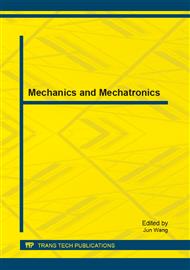[1]
K. Minxiu, Z. Yong, S. Lining, and D. Zhijiang, Analysis of a New Workspace of the Hexaglide as a Motion Simulator for Fuel Tanker Trucks, in Mechatronics, ICM2007 4th IEEE International Conference on, 2007, pp.1-6.
DOI: 10.1109/icmech.2007.4279995
Google Scholar
[2]
W. Dong, Z. Du, Y. Xiao, and X. Chen, Development of a parallel kinematic motion simulator platform, Mechatronics, vol. 23, pp.154-161, (2013).
DOI: 10.1016/j.mechatronics.2012.10.004
Google Scholar
[3]
Z. Lei, J. Hongzhou, and L. Hongren, Object-oriented landing gear model in a PC-based flight simulator, Simulation Modelling Practice and Theory, vol. 16, pp.1514-1532, (2008).
DOI: 10.1016/j.simpat.2008.08.009
Google Scholar
[4]
D. A. Axinte, J. M. Allen, R. Anderson, I. Dane, L. Uriarte, and A. Olara, Free-leg Hexapod: A novel approach of using parallel kinematic platforms for developing miniature machine tools for special purpose operations, CIRP Annals - Manufacturing Technology, vol. 60, pp.395-398, (2011).
DOI: 10.1016/j.cirp.2011.03.024
Google Scholar
[5]
Y. Lu, J. Xu, and J. Yu, Using CAD geometric variation approach machining complex workpiece by a 3-SPR parallel machine tool, Robotics and Computer-Integrated Manufacturing, vol. 26, pp.130-136, (2010).
DOI: 10.1016/j.rcim.2009.09.003
Google Scholar
[6]
D. Kanaan, P. Wenger, and D. Chablat, Kinematic analysis of a serial–parallel machine tool: The VERNE machine, Mechanism and Machine Theory, vol. 44, pp.487-498, (2009).
DOI: 10.1016/j.mechmachtheory.2008.03.002
Google Scholar
[7]
T. Inaba, I. Nishimura, T. Katoh, T. Masuda, M. Fujiwara, Y. Kasai, and M. Tokuda, Mechanical evaluation of spinal deformation using 6-axis material testing machine, Journal of Biomechanics, vol. 39, Supplement 1, p. S104, (2006).
DOI: 10.1016/s0021-9290(06)83311-7
Google Scholar
[8]
D. W. Clarke and C. J. Hinton, Adaptive control of materials-testing machines, Automatica, vol. 33, pp.1119-1131, (1997).
DOI: 10.1016/s0005-1098(97)00013-7
Google Scholar
[9]
M. Noban, H. Jahed, S. Winkler, and A. Ince, Fatigue characterization and modeling of 30CrNiMo8HH under multiaxial loading, Materials Science and Engineering A, vol. 528, pp.2484-2494, (2011).
DOI: 10.1016/j.msea.2010.11.075
Google Scholar
[10]
D. Mohr and M. Oswald, A new experimental technique for the multi-axial testing of advanced high strength steel sheets, Experimental Mechanics, vol. 48, pp.65-77, (2008).
DOI: 10.1007/s11340-007-9053-9
Google Scholar
[11]
R. G. Roberts, Minimal realization of a spatial stiffness matrix with simple springs connected in parallel, IEEE Transactions on Robotics and Automation, vol. 15, pp.953-958, (1999).
DOI: 10.1109/70.795799
Google Scholar
[12]
T. Patterson and H. Lipkin, A Classification of robot compliance, Journal of Mechanical Design, Transactions Of the ASME, vol. 115, pp.581-584, (1993).
DOI: 10.1115/1.2919229
Google Scholar
[13]
Y. Li and Q. Xu, Stiffness analysis for a 3-PUU parallel kinematic machine, Mechanism and Machine Theory, vol. 43, pp.186-200, (2008).
DOI: 10.1016/j.mechmachtheory.2007.02.002
Google Scholar
[14]
A. Codourey, M. Honegger, E. Burdet, and I. F. o. A. Control, A body-oriented method for dynamic modeling and adaptive control of fully parallel robots, presented at the Robot Control 1997 v. 2, (1998).
DOI: 10.1016/s1474-6670(17)44299-6
Google Scholar
[15]
J. Gallardo, J. M. Rico, A. Frisoli, D. Checcacci, and M. Bergamasco, Dynamics of parallel manipulators by means of screw theory, Mechanism and Machine Theory, vol. 38, pp.1113-1131, (2003).
DOI: 10.1016/s0094-114x(03)00054-5
Google Scholar
[16]
S. Staicu and D. Zhang, A novel dynamic modelling approach for parallel mechanisms analysis, Robotics and Computer-Integrated Manufacturing, vol. 24, pp.167-172, (2008).
DOI: 10.1016/j.rcim.2006.09.001
Google Scholar
[17]
T. D. Thanh, J. Kotlarski, B. Heimann, and T. Ortmaier, Dynamics identification of kinematically redundant parallel robots using the direct search method, Mechanism and Machine Theory, vol. 52, pp.277-295, (2012).
DOI: 10.1016/j.mechmachtheory.2012.02.002
Google Scholar


